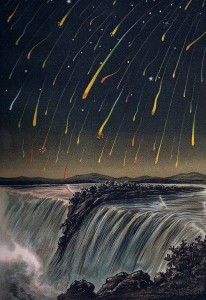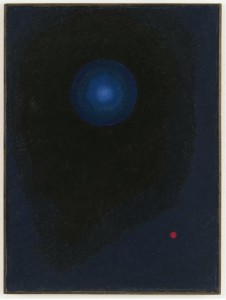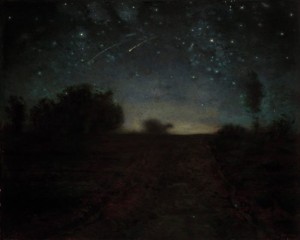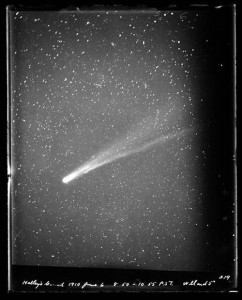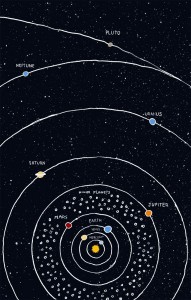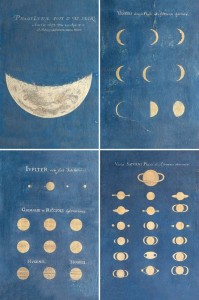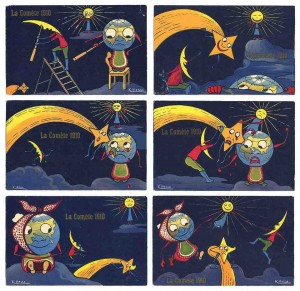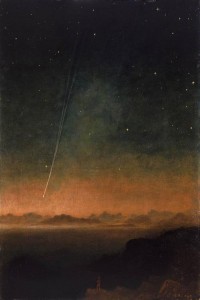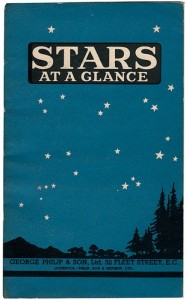Leonid Meteor Storm, as seen over North America on the night of November 12-13, 1833, from E. Weiß’s “Bilderatlas der Sternenwelt” (1888). Via Stephen Ellcock.
Images
Starry Night, by Jean-François Millet (1851)
From Stephen Ellcock‘s fabulous Facebook archive.
Maria Mitchell’s 195th Birthday on Google
Check out Google’s homepage today. That’s Maria Mitchell, the first professional female American astronomer. The comet she discovered in 1847 (by spying from her roof?) became known as “Miss Mitchell’s Comet.” King Frederick of Denmark awarded her a medal for her achievements; the medal read, “Not in vain do we watch the setting and rising … Read more
Halley’s Comet
No. 8 and last in our Comet a Week series, the most famous of them all: Halley’s Comet.
Halley’s is a 76-year-period comet, named after Sir Edmund Halley, who was the first to successfully calculate a comet’s orbit and predict its return. Since that 1759 apparition, astronomers have plotted Halley’s regular reappearances back to 240 BCE. Its most recent apparitions were in 1910 and 1986. The next one will be in 2061.
Halley’s 1910 appearance especially inflamed popular imagination. There were the usual comet panics and doomsday predictions; some astronomers warned that gases from its tail would poison life on Earth, and gas masks and anti-comet pills were sold.
The comet appeared in advertisements, songs, and on postcards. In larger cities, hotels hosted comet parties on their roofs.
And in case you’re curious, here’s a recording of “Halley’s Comet Rag”:
The Minor Planets: Who Knew There Were So Many?
At first I thought this simplified illustration of the solar system was whimsical and interesting, but hardly accurate. That band of “Minor Planets” between Jupiter and Mars–that couldn’t be right, could it?
Ah, but it’s true. Hundreds of thousands of minor planets have been discovered within the solar system and thousands more are discovered each month (from Wikipedia). That band in the diagram is more often referred to as the Asteroid Belt, but asteroids are only one class of minor planets bouncing around the Sun.
There are also Dwarf Planets, Centaurs, Trojans, and Trans-Neptunian Objects like Cubewanos and Plutinos–all “minor planets” in our solar system.
The Minor Planet Center, of the International Astronomical Union, logs the many, many minor planets as they’re discovered, along with comets.
Their Latest Published Data indicates, incredibly, 100,913,328 observed Minor Planets and 658,679 comets.
I haven’t been able to find out who the artist of that illustration is, by the way.
Moon and Planet Phases, 17th Cen.
Maria Clara Eimmart (1676-1707). Phase of the Moon, Phases of Venus, Aspects of Jupiter, Aspects of Saturn, late 17th century.
Our Moon tonight, by the way, is a waxing crescent.
From Stephen Ellcock’s “The Celestial Archive: Pre-Space Age Images of the Heavens.”
The Great Comet of 1910
Another find from Stephen Ellcock, a series of French postcards published to commemorate the appearance of The Great Comet of 1910.
An odd narrative in the cards: The Earth, Moon, and Sun are anxiously watching the approach of the comet. At first they welcome the comet, but then the comet strikes the Earth, getting one of its points embedded near Alaska. The Moon and the Sun pull the comet free, and it sails off, crying blood tears, while the Earth recovers with a bandage.
The Great Comet of 1843
Another great comet image from Stephen Ellcock. This is The Great Comet of 1843, famous for its extraordinarily long tail–the longest that had ever been observed on a comet. Painting by astronomer Charles Piazzi Smith.
Vintage Book Covers
A nice cover from an old book about astronomy. You can see hundreds more of vintage book covers on the Facebook page Perfectly Bound: The Dying Arts of Book Design and Binding.
